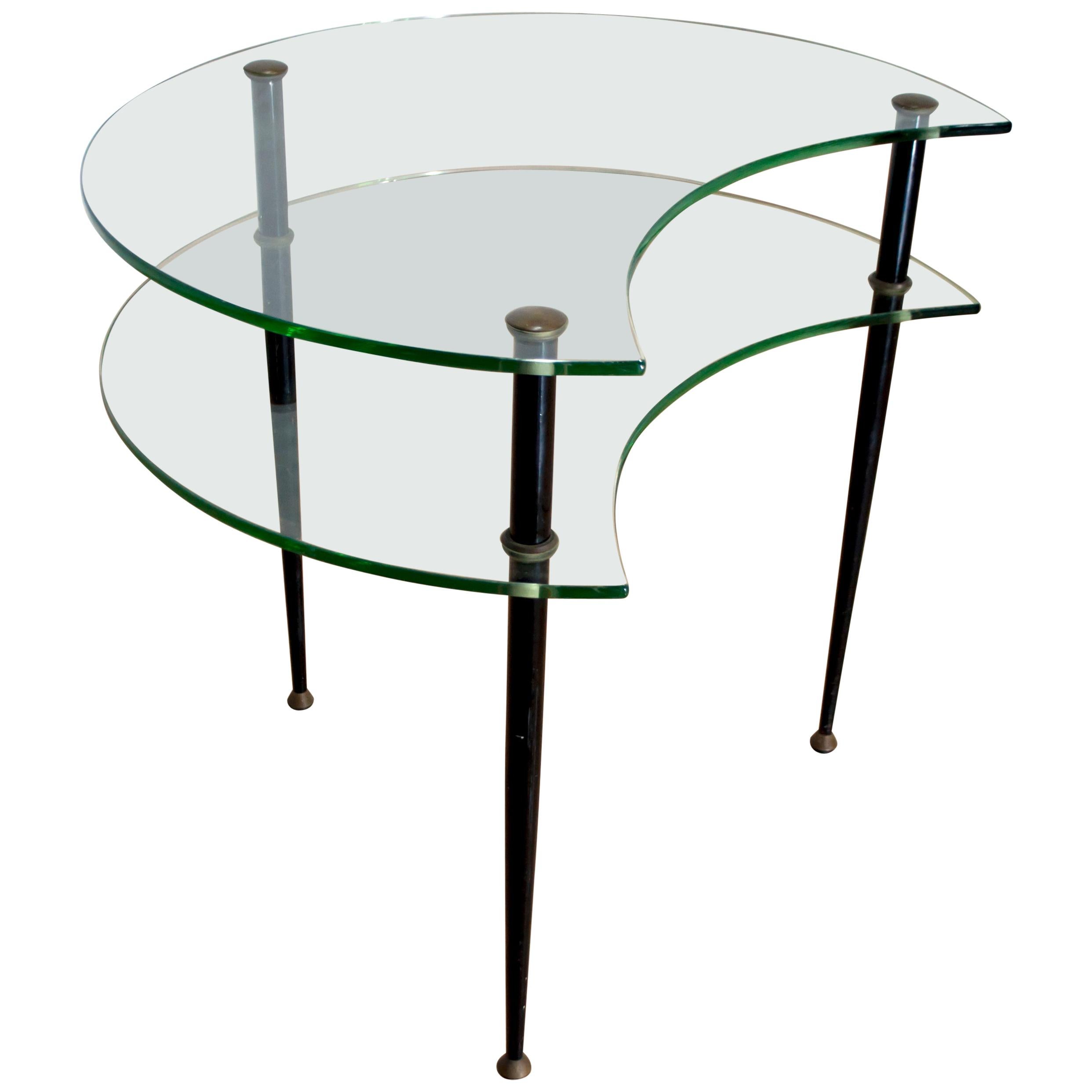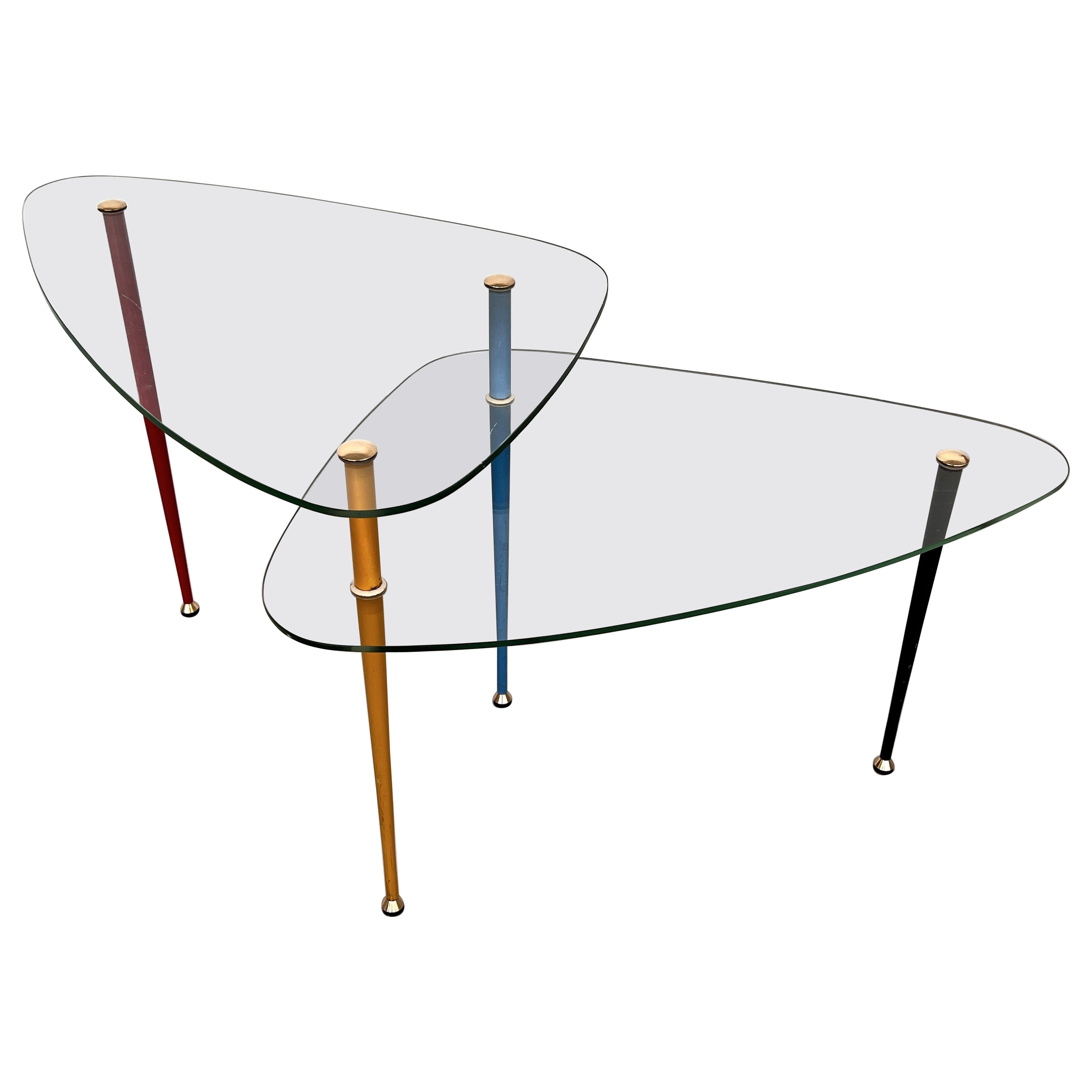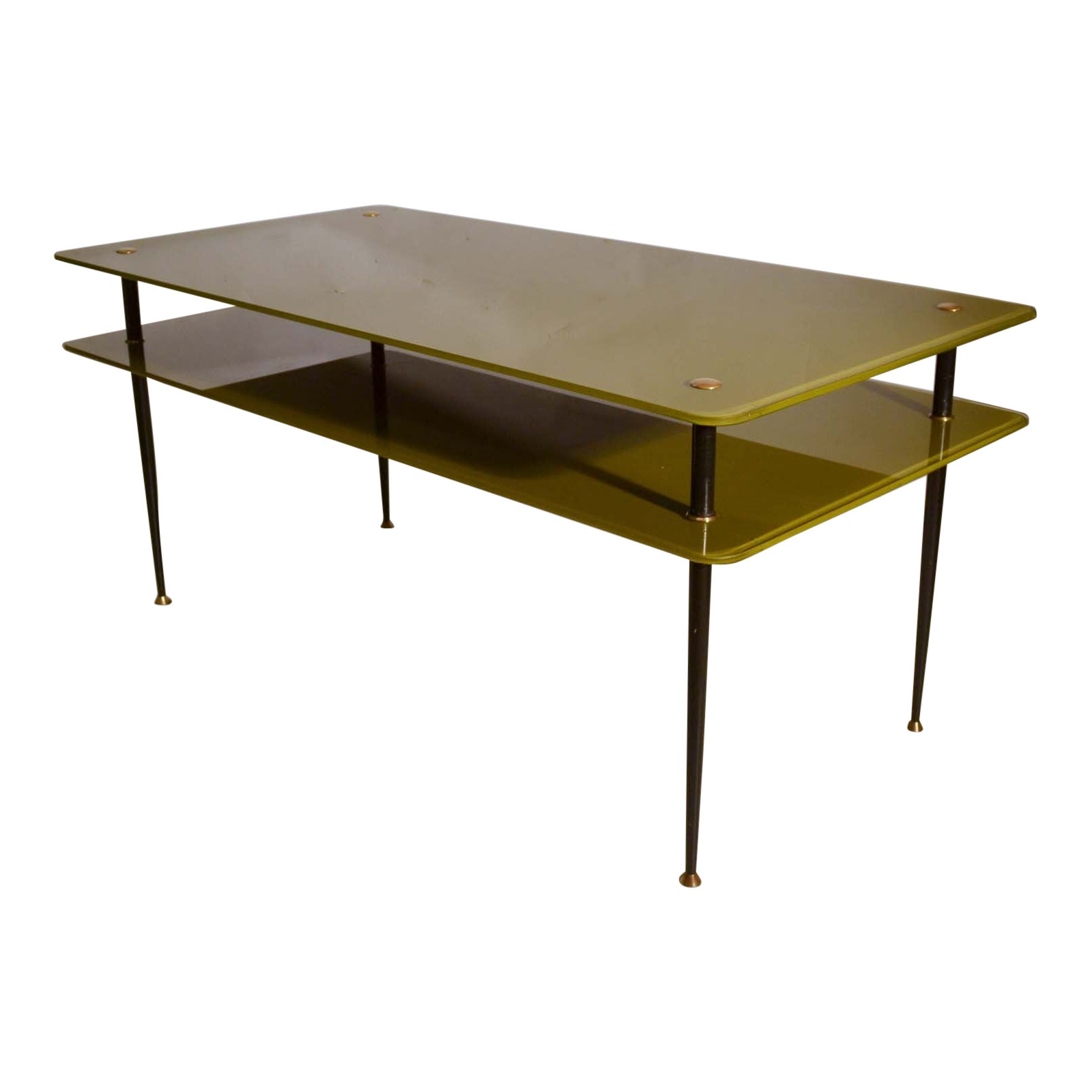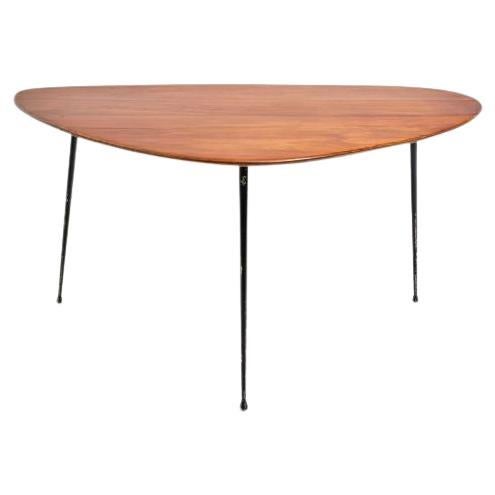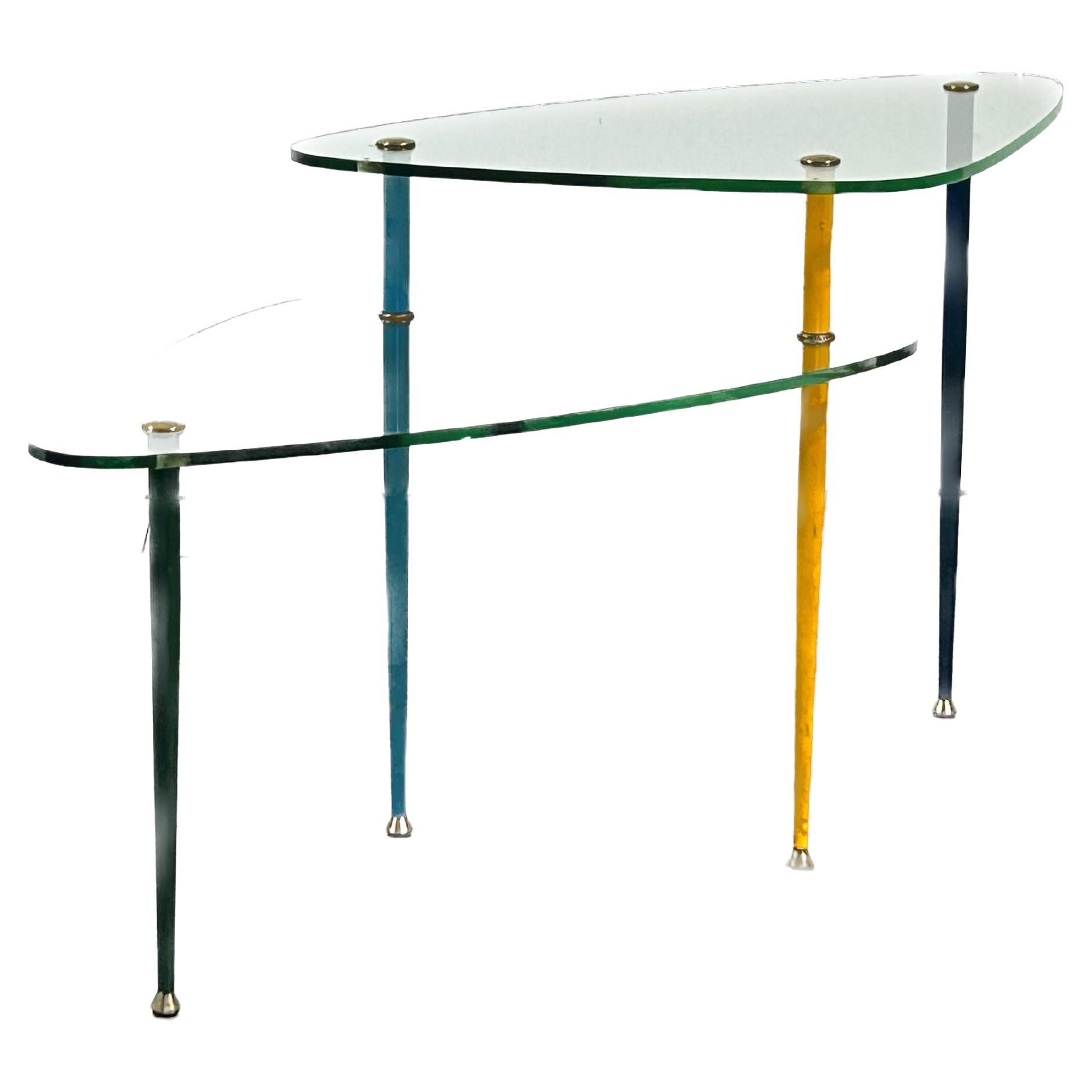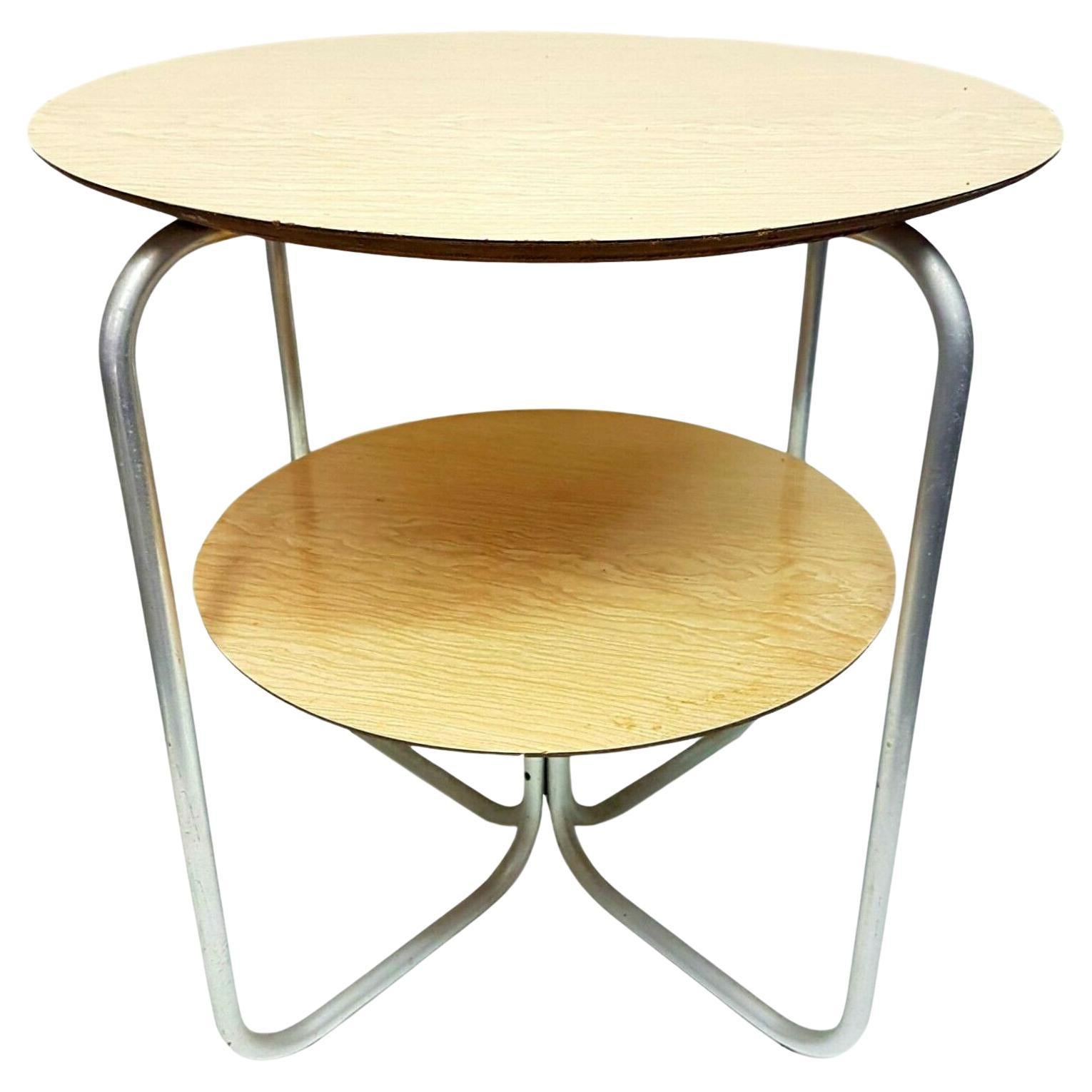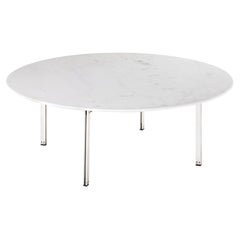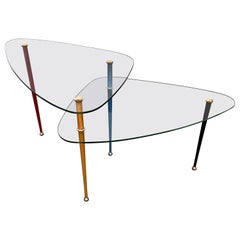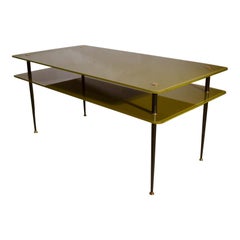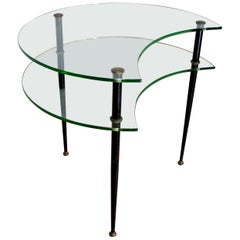
Edoardo Paoli Set of Three Arlecchino Coffee Tables Glass and Metal 1950s Italy
View Similar Items
Want more images or videos?
Request additional images or videos from the seller
1 of 9
Edoardo Paoli Set of Three Arlecchino Coffee Tables Glass and Metal 1950s Italy
About the Item
- Creator:Edoardo Paoli (Designer),Vitrex (Manufacturer)
- Dimensions:Height: 21.46 in (54.5 cm)Width: 21.26 in (54 cm)Depth: 18.9 in (48 cm)
- Style:Mid-Century Modern (Of the Period)
- Materials and Techniques:
- Place of Origin:
- Period:
- Date of Manufacture:1950s
- Condition:Wear consistent with age and use.
- Seller Location:Montecatini Terme, IT
- Reference Number:1stDibs: LU5304221658712
About the Seller
4.9
Gold Seller
These expertly vetted sellers are highly rated and consistently exceed customer expectations.
1stDibs seller since 2020
102 sales on 1stDibs
More From This SellerView All
- Gio Ponti Round Coffee Table in Walnut Wood Italian Manufacture 1950sBy Gio PontiLocated in Montecatini Terme, ITRound coffee table realized in walnut wood with metal details, the tabletop presents an elegant circular decorative motif. Attribuited to Gio Ponti, Italian manufacturer from the 1950s Gio Ponti was an icon of the modernist movement: the Italian designer, architect, artist and publisher contributed significantly to the worlds of architecture and design with his extensive work in fine furniture and ceramics, education, office and residential buildings, and everything in between. Giovanni, known as Gio Ponti was born in 1891 in Milan. It was there that he spent his childhood, and in 1921 he began to study architecture at the Politecnico di Milano. From 1923 to 1930 he served as the artistic director of the Richard-Ginori porcelain factory. In 1927, Ponti started his first architectural office, together with Emilio Lancia, and in 1928 he started the magazine Domus, which is still regarded as one of the most influential European magazines for architecture and design. He was also very influential during the period as a curator of the Milan Triennale. After his collaboration with Emilio Lancia had come to an end, upon completion of the Torre Rasini, he began to work as an architect together with the engineers Antonio Fornaroli and Eugenio Soncini...Category
Vintage 1950s Italian Mid-Century Modern Coffee and Cocktail Tables
MaterialsMetal
$1,837 Sale Price40% Off - Florence Knoll Round Low Table in White Marble and Metal by Knoll 1950s ItalyBy Knoll, Florence KnollLocated in Montecatini Terme, ITLow table with a round-shaped table top in white marble and four metal legs from the Parallel Bar series, designed by Florence Knoll and manufactured by Knoll International during the 1950s. Born to a baker, and orphaned at age twelve, Florence Schust grew up in Saginaw, Michigan. Schust demonstrated an early interest in architecture and was enrolled at the Kingswood School for Girls, adjacent to the Cranbrook Academy of Art. While at Kingswood, Florence befriended Eilel Saarinen, whom she would later study under at Cranbrook. Warmly embraced by the Saarinen family, Florence vacationed with them in Finland, enjoyed the company of their accomplished friends, and formed a very close relationship with Eliel’s son, Eero. The connections she made and the skills she developed while at Cranbrook were the foundations of Florence Schust’s incredible design education and pioneering career. With recommendations from Eliel Saarinen and Alvar Aalto, Florence went on to study under some of the greatest 20th century architects, including Walter Gropius and Marcel Breuer in Cambridge, Massachusetts and Ludwig Mies van der Rohe at the Illinois Institute of Technology. In 1941 Florence moved to New York where she met Hans Knoll who was establishing his furniture company. With Florence’s design skills and Hans’ business acumen and salesmanship, the pair, who married in 1946, grew the nascent company into an international arbiter of style and design. Florence also seeded contributions with her friends Eero Saarinen, Harry Bertoia, and Mies van der Rohe. In creating the revolutionary Knoll Planning Unit, Florence Knoll defined the standard for the modern corporate interiors of post-war America. Drawing on her background in architecture, she introduced modern notions of efficiency, space planning, and comprehensive design to office planning. Florence ardently maintained that she did not merely decorate space. She created it. The Planning Unit rigorously researched and surveyed each client — assessing their needs, defining patterns of use and understanding company hierarchies — before presenting a comprehensive design, informed by the principles of modernism and beautifully executed in signature Knoll style. Florence and the Planning Unit were responsible for the interiors of some of America’s largest corporations, including IBM, GM and CBS. As part of her work with the Planning Unit, Florence frequently contributed furniture designs to the Knoll catalog...Category
Vintage 1950s Italian Mid-Century Modern Coffee and Cocktail Tables
MaterialsMarble, Metal
- Franco Albini TL30 Round Table in Metal and Wood for Poggi Pavia 1950s ItalyBy Franco Albini, PoggiLocated in Montecatini Terme, ITRound table model TL30 with black lacquered metal base and a wooden top. Designed by Franco Albini for Poggi, Pavia in 1950s. After spending his childhood and part of his youth in Robbiate in Brianza, where he was born in 1905, Franco Albini moved with his family to Milan. Here he enrolled in the Faculty of Architecture of the Polytechnic and graduated in 1929. He starts his professional activity in the studio of Gio Ponti and Emilio Lancia, with whom he collaborates for three years. He probably had his first international contacts here In those three years, the works carried out are admittedly of a twentieth-century imprint. It was the meeting with Edoardo Persico that marked a clear turning point towards rationalism and the rapprochement with the group of editors of “Casabella”. The new phase that that meeting provoked starts with the opening of the first professional studio in via Panizza with Renato Camus and Giancarlo Palanti. The group of architects began to deal with public housing by participating in the competition for the Baracca neighborhood in San Siro in 1932 and then creating the Ifacp neighborhoods: Fabio Filzi (1936/38), Gabriele D’Annunzio and Ettore Ponti (1939). Also in those years Albini worked on his first villa Pestarini. But it is above all in the context of the exhibitions that the Milanese master experiments his compromise between that “rigor and poetic fantasy” coining the elements that will be a recurring theme in all the declinations of his work – architecture, interiors, design pieces . The opening in 1933 of the new headquarters of the Triennale in Milan, in the Palazzo dell’Arte, becomes an important opportunity to express the strong innovative character of rationalist thought, a gym in which to freely experiment with new materials and new solutions, but above all a “method”. Together with Giancarlo Palanti, Albini on the occasion of the V Triennale di Milano sets up the steel structure house, for which he also designs the ‘furniture. At the subsequent Triennale of 1936, marked by the untimely death of Persico, together with a group of young designers gathered by Pagano in the previous edition of 1933, Franco Albini takes care of the preparation of the exhibition of the house, in which the furniture of three types of accommodation. The staging of Stanza per un uomo, at that same Triennale, allows us to understand the acute and ironic approach that is part of Albini, as a man and as a designer: the theme addressed is that of the existenzminimum and the reference of the project is to the fascist myth of the athletic and sporty man, but it is also a way to reflect on low-cost housing, the reduction of surfaces to a minimum and respect for the way of living. In that same year Albini and Romano designed the Ancient Italian Goldsmith’s Exhibition: vertical uprights, simple linear rods, design the space. A theme, that of the “flagpole”, which seems to be the center of the evolution of his production and creative process. The concept is reworked over time, with the technique of decomposition and recomposition typical of Albinian planning: in the setting up of the Scipio Exhibition and of contemporary drawings (1941) the tapered flagpoles, on which the paintings and display cases are hung, are supported by a grid of steel cables; in the Vanzetti stand (1942) they take on the V shape; in the Olivetti store in Paris (1956) the uprights in polished mahogany support the shelves for displaying typewriters and calculators. The reflection on this theme arises from the desire to interpret the architectural space, to read it through the use of a grid, to introduce the third dimension, the vertical one, while maintaining a sense of lightness and transparency. The flagpole is found, however, also in areas other than the exhibition ones. In the apartments he designed, it is used as a pivot on which the paintings can be suspended and rotated to allow different points of view, but at the same time as an element capable of dividing spaces. The Veliero bookcase...Category
Vintage 1950s Italian Mid-Century Modern Dining Room Tables
MaterialsMetal
$2,450 Sale Price20% Off - Gio Ponti Coffee Table in Wood and Glass by Figli di Amedeo Cassina 1950sBy Figli di Amadeo Cassina, Gio PontiLocated in Montecatini Terme, ITCoffee or occasional table with structure in wood a removable center part in sheet metal and a rectangular shaped table top designed by Gio Ponti and produced by Figli di Amedeo Cassina...Category
Vintage 1950s Italian Mid-Century Modern Coffee and Cocktail Tables
MaterialsMetal
- Gio Ponti Table in Oak Brass and Red Laminate Italian Manifacture 1950sBy Gio PontiLocated in Montecatini Terme, ITLarge table or desk with structure in oak wood, tabletop in red laminate and brass details. Designe by Gio Ponti, Italian manufacture from the 1950s. Gio Ponti was an icon of the m...Category
Vintage 1950s Italian Mid-Century Modern Tables
MaterialsBrass
- Console Table in Black Lacquered Wood and Pink Marble Italian Manufacture 1950sLocated in Montecatini Terme, ITA Mid-Century Modern style console table with a structure in black lacquered wood and a tabletop in pink marble. The console table presents a single drawer on the frontal part. ...Category
Vintage 1950s Italian Mid-Century Modern Console Tables
MaterialsMarble
$2,297 Sale Price30% Off
You May Also Like
- Italian "Arlecchino" Side Table in Glass by Edoardo Paoli for Vitrex, 1950sBy Vitrex, Edoardo PaoliLocated in Morazzone, VareseCoffee table or sofa table in kidney shape, Model "Arlecchino" with multicolored painted metal legs in red, yellow, black and blue with brass details on two kidney-shaped tempered gl...Category
Vintage 1950s Italian Mid-Century Modern Side Tables
MaterialsMetal
- Olive Green Glass Coffee Table by Eduardo Paoli for Vitrex, Italy 1950sBy Vitrex, Edoardo PaoliLocated in London, GBOlive green double layered tempered and painted glass coffee table connected by four black lacquered metal tapered legs. They are highlighte...Category
Vintage 1950s Italian Mid-Century Modern Coffee and Cocktail Tables
MaterialsMetal, Brass
- Edoardo Paoli Mid-Century Modern Italian Two Shelves Coffee Table by Vitrex 1955By Vitrex, Edoardo PaoliLocated in Puglia, PugliaThis coffee table was designed by Edoardo Paoli around 1955 and is made of lacquered brass and tempered glass and was produced by Vitrex. It has two half-moon glass tops on three bla...Category
Vintage 1950s Italian Mid-Century Modern Coffee and Cocktail Tables
MaterialsCrystal, Brass
- Mid-Century Italian Coffee Table, C.1950sLocated in London, GBMid-century design Italian coffee table, circa 1950s, in wood, brass and painted metal. Dimensions: H 50 x W 105 x W 61 cm.Category
20th Century Italian Mid-Century Modern Coffee and Cocktail Tables
MaterialsWood
- 1950ies Two-Tiered Arlecchino Side Table Designed by Eduardo Paoli in 1955By Vitrex, Edoardo PaoliLocated in Offenburg, Baden Wurthemberg1950ies two-tiered Arlecchino side table designed by Eduardo Paoli in 1955. Manufactured by Vitrex, Italy ca. in 1960. Beautiful small side or coff...Category
Vintage 1950s Italian Mid-Century Modern Side Tables
MaterialsMetal, Brass
- Large Brass and Glass Coffee Table, France, circa 1950sLocated in Isle Sur La Sorgue, VaucluseLow coffee table of striking design. The brass base (hollow, and surprisingly light) is made up of four interlocked rectangles, supported by four feet, so that the rectangles are com...Category
Mid-20th Century French Mid-Century Modern Coffee and Cocktail Tables
MaterialsBrass
Recently Viewed
View AllMore Ways To Browse
Retro Table Tops
Set Of Mid Century Coffee Table
Three Leg Coffee
Three Legs Coffee Table
Midcentury Metal And Glass Coffee Table
Three Leg Coffee Table
Mid Century Metal And Glass Coffee Table
Glass Coffee Table Sets
1950s Glass Top Coffee Table
Black Coffee Set
Italy Coffee Set
Metal And Glass Mid Modern Coffee Table
Painted Glass Coffee Table
1950s Cocktail Set
Glass Table With Metal Legs
Coffee Table Set Of Two
Set Of Italian Coffee Tables
Set Of Three Tables Italy
